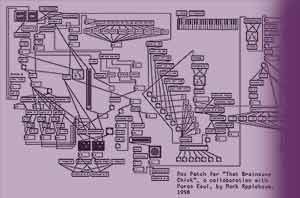
 That Brainwave Chick is a performance piece that was begun in January of 1998 and has evolved ever since. Thus far, Chick has been performed in numerous locations and venues, including a performance and lecture/demonstration at The Walker Art Center in Minneapolis as part of the American Composers Forum’s Sonic Circuits VI electronic media festival, and a performance at the SIGGRAPH conference in Los Angeles.
That Brainwave Chick is a performance piece that was begun in January of 1998 and has evolved ever since. Thus far, Chick has been performed in numerous locations and venues, including a performance and lecture/demonstration at The Walker Art Center in Minneapolis as part of the American Composers Forum’s Sonic Circuits VI electronic media festival, and a performance at the SIGGRAPH conference in Los Angeles.In performance, both Kaul and I sit onstage at separate ends, each of us at our own computer. The chain of events begins with her brainwaves which are monitored on her computer via EEG and Fourier-transformed into frequency and amplitude values. Brainwave activity can be subdivided into several domains or states: beta, alpha, theta, and delta. Each state represents a frequency range.
Paras is very skilled at "switching" between brainwave states. She has practiced this process extensively over many years and is able to attain particular states at will. (This is hardly the case for me: when I try to switch among states I can almost never get out of high beta; whenever the computer alerts me that I have entered alpha, I immediately get so excited that I go back to high beta. We leave the switching part to her.)
We convert her frequency and amplitude values into MIDI note numbers and velocities, respectively. (We occasionally reverse this assignation, or apply these values to other MIDI parameters.) These MIDI values are sent to my computer where they enter a "patch" that I have composed within Opcode’s MAX software. MAX processes the incoming values, as explained below. MIDI commands are sent out of my computer to synthesizer sound modules that articulate the brainwaves through speakers. A feedback loop arises in that Paras hears the result of the process and automatically makes a neurological response.
(Technical Interlude. The synthesizers are all rack units: Yamaha EX5R, E-MU Proteus 2000, Oberheim Matrix-1000, and Kurzweil 1000PX. I am currently in the process of incorporating MSP into the set-up.)
The MAX patch becomes a kind of neural net, searching for certain conditions and responding in both causal and non-linear ways. For example, brainwave tendencies might determine how pitches are harmonized. The time spent in a particular mental state might determine the duration before a given note is echoed. Or, brainwave amplitudes above a certain threshold might engender a change of synthesizer timbre. Our MAX patch cross-maps data values. This creates a relatively complex condition whereby the brain is purposely kept in a state of infancy, continually trying to learn how to play the patch. In fact, for every successive performance, I modify the patch in an attempt to complicate or more finely-resolve the expressive link between Paras and me.
I can change the patch itself in real-time by altering its values with a Peavey PC 1600x continuous MIDI controller. The controller is essentially a row of faders and buttons that can be assigned to any aspect within the MAX patch. In the same way that improvisation is a kind of real-time composition, the MIDI controller allows me to change my composition in real-time, to improvise a response to Paras.
While the sound is generated, the audience views three projected images: first is the MAX patch with its blinking lights, changing numbers, and moving graphic sliders and knobs; second is a three-dimensional, animated graphic display of the amplitude and frequencies of the brainwaves, color-coded to reflect brainwave states; and third is a colorful animation of Paras’ creation that changes hue in coordination with her current brainwave state.
The program notes for That Brainwave Chick are divided into eight statements or paragraphs. The notes do not appear in printed form but are spoken during the performance. At various times I fade the music down to a low level and one of us will orate one of the eight statements. We never know what order the statements will be delivered, when a delivery will be made, or who will be the speaker. MAX simultaneously runs a subroutine that makes these determinations randomly, suddenly alerting me that, for example, Paras is now to read statement number four. Often Paras is in deep concentration with her eyes closed. To get her attention, I send her a message via Ethernet cable. The cable isn’t actually plugged into anything. The cable is simply tied around her wrist; I give it a tug to get her attention.